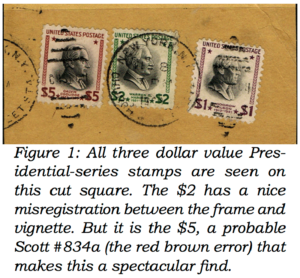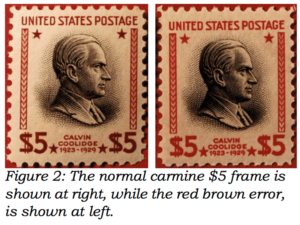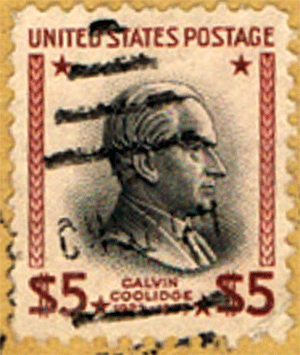by John M. Hotchner
The hunter dreams of a 14-point buck! The stamp collector has equally desirable quarry, and the hunting ground is at any nearby stamp show!
 The eight-day international show in New York in 2016 was a
lollapalooza of an
event; a familiar
local show on steroids; with more
than 200 dealers
from around the
world to serve the
tastes of collectors from beginner status to the most discriminating specialist. As one somewhere in the middle of that pack, I was worried that the dealer community would have only expensive material because of the high booth fees an international show commands. I needn’t have been concerned. There was plenty of moderately priced material for all of us without bottomless wallets.
The eight-day international show in New York in 2016 was a
lollapalooza of an
event; a familiar
local show on steroids; with more
than 200 dealers
from around the
world to serve the
tastes of collectors from beginner status to the most discriminating specialist. As one somewhere in the middle of that pack, I was worried that the dealer community would have only expensive material because of the high booth fees an international show commands. I needn’t have been concerned. There was plenty of moderately priced material for all of us without bottomless wallets.
My shopping time was limited by other activities, but over the last three days I got in about six hours of digging through the stocks of a dozen or so dealers.
At every show I go to I hope to make one good find to add to my collection; something that is a combination of good price and interesting item that I can enjoy for years afterward. Often enough, it doesn’t happen (no great items, or a great item at too high a price), but the search is fun, and almost always something of interest will be found to make it worthwhile.
At the New York show two items came my way, and the rest of this column will be devoted to one of them because I am certain there are more examples “out there” waiting to be found.
 Poking through the U.S. cover stock of a dealer from another country, I saw a cut square with the dollar values of the 1938 Prexie series, priced at $35. Cancelled in New York City on February 8 of a year that is unclear, it is shown in Figure 1. Given that the catalogue values of the three used stamps is $7, I hesitated. The combination is unusual, but 5x catalog unusual?
Poking through the U.S. cover stock of a dealer from another country, I saw a cut square with the dollar values of the 1938 Prexie series, priced at $35. Cancelled in New York City on February 8 of a year that is unclear, it is shown in Figure 1. Given that the catalogue values of the three used stamps is $7, I hesitated. The combination is unusual, but 5x catalog unusual?
Taking a closer look, the first thing to be noticed was that the $2 is a nice color misregistration. I like to find the heads of the dollar value Prexies misregistered in one direction or another, and the $2 is the hardest to find. On this one the vignette is quite far to the left; which would not please Republican Pres. Warren G. Harding, who is pictured on the stamp.
Next was noticing that the Calvin Coolidge head on the $5 was low on that stamp. At about this time, I concluded that the $35 asking price was reasonable, and I reached for my wallet.
 But wait — something about that $5 rang a bell. The reddish frame color was much darker than the normal “carmine” noted in the Scott Catalogue. Having seen this before on mint $5 examples submitted for expertizing, my mind’s eye pictured a reference photo I had been given by the late Joseph Thompson, who was a scholar in this realm. The photo is shown in Figure 2.
But wait — something about that $5 rang a bell. The reddish frame color was much darker than the normal “carmine” noted in the Scott Catalogue. Having seen this before on mint $5 examples submitted for expertizing, my mind’s eye pictured a reference photo I had been given by the late Joseph Thompson, who was a scholar in this realm. The photo is shown in Figure 2.
Could the $5 on this cut square be the rather rare “red brown” error that is listed in Scott’s? For $35 I was more than willing to take a chance until I could get it home and check my reference material.
Fast-forward a week, and I am pleased to say that the variety checks out. It appears to be what Scott calls No. 834a, red brown and black, mint value (never hinged) $2750; used in period, $7000. It only remains to have it expertized.
What is the story to this stamp, and why is the used value so much higher than the mint? A dive into my files provides considerable detail, which I will summarize below based on several articles from the philatelic press, auction listings, and a Thompson article* from The United States Specialist, monthly magazine of the United States Stamp Society.
All telling of the story of the #834a agree that the first reports of the error in the trade are attributed to U.S. expert and philatelic columnist (for Mekeel’s) George B. Sloane, in about 1947. He sent one on approval to a potential buyer in 1951 (asking price $75), writing the following note:
“I thought you would like to see the stamp. It was a comparatively small lot — about 90 stamps (most in blocks). I have held them up for almost four years but no more have shown up. It is my opinion that the stamp will continue to advance…. The color is definite and marked.”
Sloane had queried the Bureau of Engraving and Printing, the printer of these stamps, in 1950, and provided samples. He received a detailed response, dated April 18, 1950. Its essence is summarized by the following excerpt:
“…Stamps having the approximate color of these [submitted] stamps can result from either of two fundamentally different causes. Such stamps could have been produced at the time of printing in this bureau if the ink had become contaminated with minute quantities of black ink or carbon black… The second possible cause for the color of such stamps arises from the fact that the ink used in printing the border of these stamps contains certain components which darken perceptibly in the presence of a chemical… The bureau receives numerous inquiries concerning similar color changes in stamps in which it is apparent that these changes are produced by chemical treatment or by storage in the presence of certain gaseous chemicals after the stamps have left this bureau. Laboratory tests showed that five-dollar Coolidge stamps can be changed in color by chemicals so as to form an almost perfect visual color match with the stamps obtained from you…”
The letter goes on to explain that the submitted stamps were tested and determined to be unaltered by chemicals; thus a genuine variety.
Sloane’s report is, however, not the first sighting of this error. In the cited U.S. Specialist article, Thompson and Gill provide information on the first find of these stamps. They were first discovered by postal clerk Ralph Davis, who was also a well-known and respected philatelist from northern Virginia. He reported the purchase of two plate blocks of the error in 1938-39, at the post office where he worked. Given his status, he could not make a philatelic splash about his find, but he noted that other copies of the error were sold over the counter before it was noticed, identified and reported to postal authorities.
Davis told Thompson and Gill that “…over a million dollars’ worth of stamps of the error of color were recalled and destroyed when they were discovered.” This equates to 2,000 panes of 100 stamps with each pane containing one plate block.
As to numbers that got into philatelic hands, Thompson and Gill stated, “Since Davis said the error was sold over the counter before it was discovered, there could be any number of errors in existence. We have heard of only two canceled copies, about 100 mint singles, and nine plate blocks, although more may exist.”
So, with this background, could the Figure 1 cut square contain a genuine 834a? I would offer the following observations. The year in the cancellation cannot be determined. It would have to be 1939 or after.
The New York usage could be from the Davis find, or the Sloane find. Sloane was based in New York, but some of the undetermined number of $5 errors sold in northern Virginia could also have migrated to New York. And those purchased at Ralph Davis’ post office would likely not have been identified as anything special.
In addition I would posit that anyone trying to make examples of this error by chemically altering normal copies would identify the product as the error, so as to sell it at a premium. That clearly is not the case with the Figure 1 cut square.
Finally, chemical alterations generally affect more than just the intended color. In this case, the paper would also be altered in color. And the ultraviolet (UV) properties of the paper will also differ from normal.
Again, after inspection under 30x magnification, and with both longwave and shortwave UV, I can say that neither is the case here.
 My conclusion is that there is every likelihood that the Figure 1 example is genuine. I will submit it for expertizing, and report the results here once I have received the opinion.
My conclusion is that there is every likelihood that the Figure 1 example is genuine. I will submit it for expertizing, and report the results here once I have received the opinion.
Addendum: The Philatelic Foundation found that the stamp “is not Scott 834a, rather it is a Scott 834, carmine and black, the carmine color oxidized.” PF did not provide any information as to how they reached that conclusion.
*Thompson, Joseph S., Jr. and Gill, Norma E., “The $5 Coolidge Error of Color,” The United States Specialist, July, 1990, pp 399-410. Published by The United States Stamp Society.
Should you wish to comment on this column, or have questions or ideas you would like to have explored in a future column, please write to John Hotchner, VSC Contributor, P.O. Box 1125, Falls Church, VA 22041-0125, or email, putting “VSC” in the subject line.
Or comment right here.




Although you didn’t get the $7000 result that you would have liked, the anticipation and research was certainly worth more than $35 and that’s in addition to the actual value of the stamps. After all that’s why most of us collect.
You give me hope that in my bargain bin stamp hunting I could find something like that. Thanks.